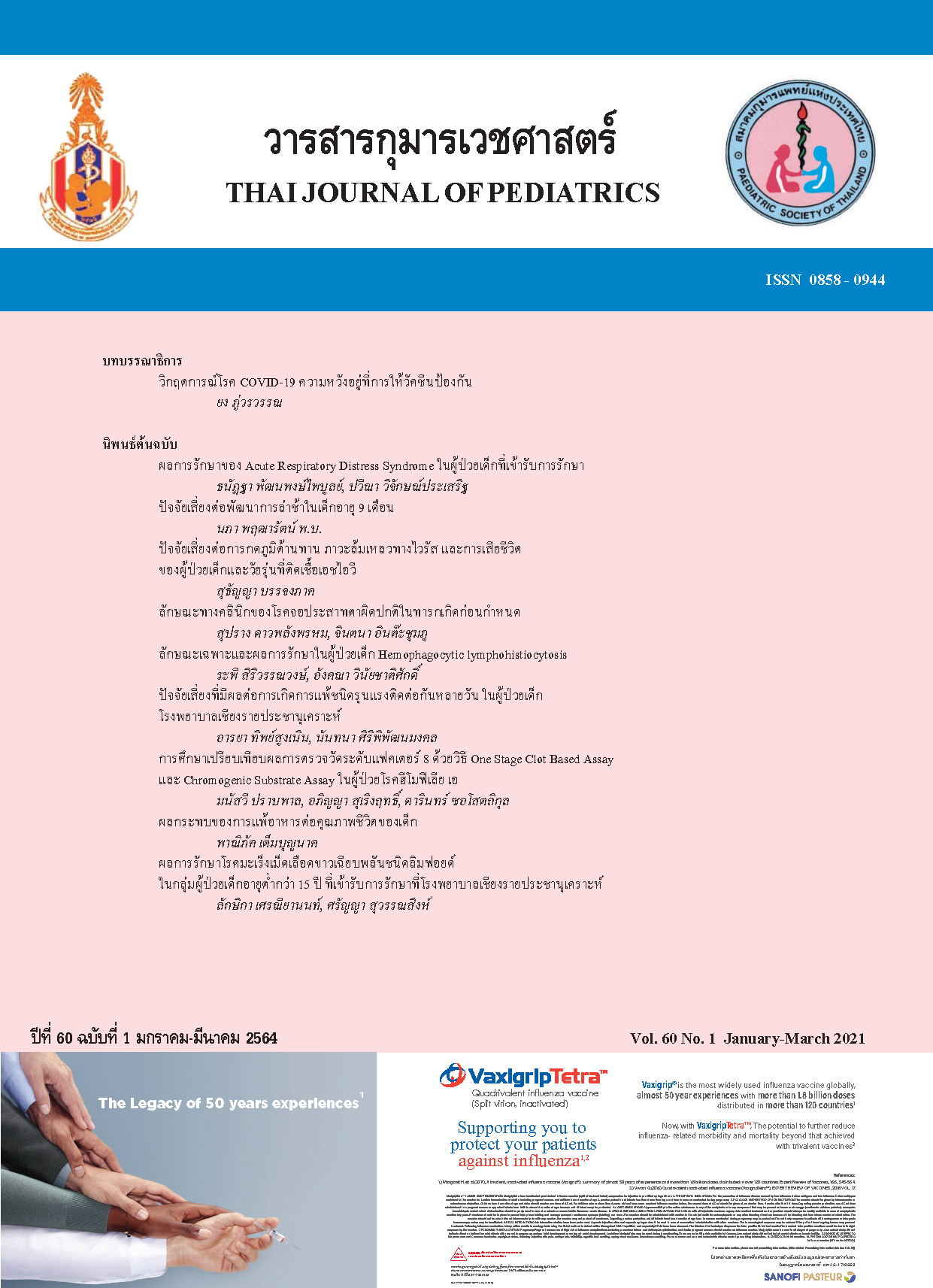Characteristics and outcomes of Hemophagocytic Lymphohistiocytosis In children
Keywords:
HLH, clinical features, children, outcomes, prognostic factorsAbstract
Background: Hemophagocytic lymphohistiocytosis (HLH) is a life-threatening condition associated with excessive or uncontrolled release of proinflammatory cytokines. Clinical manifestations include fever, splenomegaly, high serum ferritin level and cytopenia. Early diagnosis and proper management would effectively reduce mortality of this lethal condition.
Objectives: To study the etiologies, clinical characteristics, outcomes of treatment in children with HLH and determine prognostic factors for early outcomes and causes of death in children with HLH. Methods: In this retrospective descriptive study, the medical records of HLH children, who were treated at Maharat Nakhon Ratchasima Hospital from 1 January 2008 to 30 June 2018 have been reviewed. Results: Of the 48 children diagnosed with HLH, nineteen patients (40%) with infectious-associated hemophagocytic syndrome (IAHS), three patients (6%) with malignancy associated hemophagocytic syndrome, and two patients (4%) with macrophage activation syndrome. Causes of early death within 7 days included infection and multiorgan failure, which accounted for 8% of total mortality rate 29%. In comparison between the survivors and deaths, thrombocytopenia (<50,000/mm3), elevated total or
direct bilirubin (>2 mg/dL), and hypofibrinogenemia (<100 mg/dL) were statistically significant found in mortality group (P-value = 0.0005, 0.0088, 0.01, 0.015, respectively). However, age, ferritin level and neutrophil count were not statistically significant difference.
Conclusions: This study affirmed that HLH is a life-threatening condition with high mortality. High serum total and direct bilirubin, thrombocytopenia and hypofibrinogenemia conferred adverse prognostic outcomes in those HLH children.
Downloads
References
Ishii E. Hemophagocytic Lymphohistiocytosis in Children: Pathogenesis and Treatment. Frontiers in Pediatrics 2016;4:47.
M e l i s s a R G . H e m o p h a g o c y t i c lymphohistiocytosis: review of etiologies and management. Journal of Blood Medicine 2014;5:69–86
Trottestam H, Berglöf E, Horne A, Onelöv E, Beutel K, Lehmberg K, et al. Risk factors for early death in children with haemophagocytic
lymphohistiocytosis. Foundation Acta Acta Pædiatrica 2012;101:313–318.
Dao TT, Luong VT, Nguyen TT, Huynh Q, Phan T, Lam MT, et al. Risk Factors for Early Fatal Outcomes Among Children with Hemophagocytic Lymphohistiocytosis (HLH): A Single- Institution Case-Series in Vietnam. Pediatric Hematology and Oncology 2014;31:271-281.
Kaya Z, Bay A, Albayrak M, Kocak U, Yenicesu I, Gursel T. Prognostic Factors and Long-Term Outcome in 52 Turkish Children With Hemophagocytic Lymphohistiocytosis. Pediatr Crit Care Med 2015;16:e165–e173.
Wang YR, Qiu YN, Bai Y, Wang XF. A retrospective analysis of 56 children with hemophagocytic lymphohistiocytosis. Journal of Blood Medicine 2016;7:227–231.
Bin Q, Gao JH, Luo JM. Prognostic factors of early outcome in pediatric hemophagocytic lymphohistiocytosis: an analysis of 116
cases. Ann Hematol 2016;95:1411–1418.
Kim MM, Yum MS, Choi HW, Ko TS, Im HJ, Seo JJ. et al. Central nervous system (CNS) involvement is a critical prognostic factor for hemophagocytic lymphohistiocytosis. Korean J Hematol 2012;47:273-80.
V eerakul G, Sanpakit K, Tanphaichitr VS, Mahasandana C, Jirarattanasopa N. Secondary Hemophagocytic Lymphohistiocytosis
in Children: An Analysis of Etiology and Outcome. J Med Assoc Thai 2002;85:S530-541.
Janka GE. Familial hemophagocytic lymphohistiocytosis. Eur J Pediatr 1983;140:221-230.
Henter JI, Samuelsson-Horne A, Aricò M, Egeler RM, Filipovich AH, Gadner H. et al. Treatment of hemophagocytic lymphohistiocytosis with HLH-94 immunochemotherapy and bone marrow transplantation. Blood 2002;100(7):2367-2373.
Arico M, Janka G, Fischer A, Henter JI, Blanche S, Elinder G, et al. Hemophagocytic lymphohistiocytosis. Report of 122 children from the International registry. FHL Study Group of the Histiocyte Society. Leukemia 1996;10(2):197-203.
Imashuku S, Kuriyama K, Teramura T, Ishii E, Kinugawa N, Kato M, et al. Requirement for etoposide in the treatment of Epstein-Barr virus-associated hemophagocytic lymphohistiocytosis. J Clin Oncol 2001;19(10):2665-73.
Horne A, Janka G, Maarten Egeler R, Gadner H, Imashuku S, Ladisch S, et al. Haematopoietic stem cell transplantation in haemophagocytic lymphohistiocytosis. Br J Haematol 2005;129(5):622-630.
Downloads
Published
How to Cite
Issue
Section
License

This work is licensed under a Creative Commons Attribution-NonCommercial-NoDerivatives 4.0 International License.



